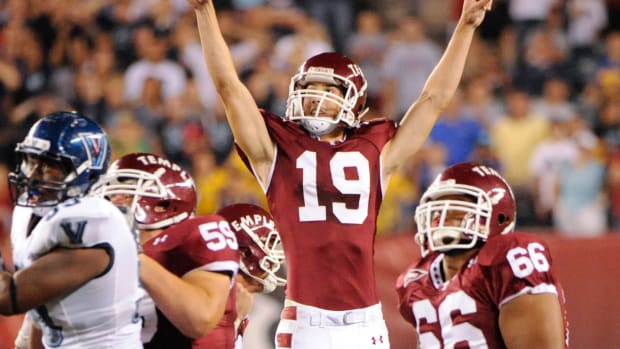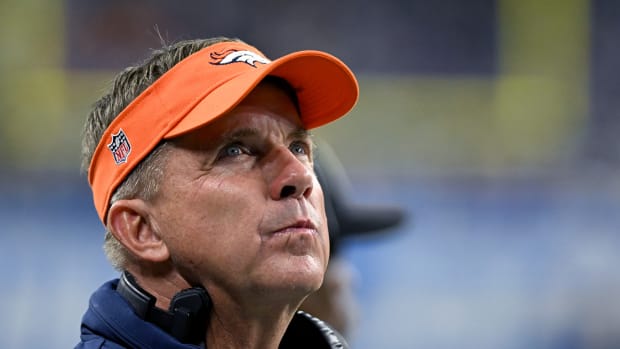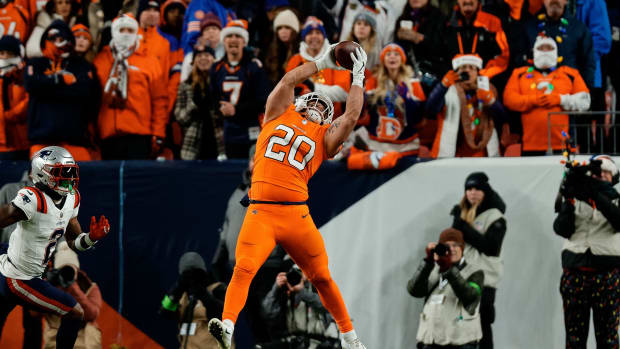Broncos 9-Point Plan to Crush Free Agency
The Denver Broncos have already made two major moves to clear cap space with the releases of cornerback A.J. Bouye and defensive lineman Jurrell Casey. Debate still continues about whether or not additional players should be released to get even more cap room.
However, the Broncos are actually in position to take care of some of their own players, while still having the space to add an outside free agent or two. I doubt GM George Paton will be that active in free agency and will instead focus more on keeping certain Broncos around.
Some people may wonder whether the Broncos actually have enough cap space, given the numbers that are being tossed around for franchise tags and restricted free-agent tenders. However, the top-51 cutoff takes effect in the offseason, meaning that once a team has 51 players under contract, each time a player is added, another player falls below the cutoff and thus no longer applies to the cap.
While the cap space that players consume won't be a lot, these small amounts add up and give a team more flexibility during the offseason. Furthermore, if a player gets a new contract, his first-year cap hit will be low, because teams will use signing bonuses to pro-rate money over the length of the contract.
This helps a team get cap flexibility for the present, though it does come with higher cap hits down the road. However, that's usually negated when other players see their deals expire or if players kept for the time being are cut the next year.
To get an idea of how this works, allow me to walk you through my offseason game plan as it pertains to free agency. The Broncos currently have $42.3 million in cap space with 56 players under contract.
Join me as I go step by step.
1. Tender Exclusive Rights Free Agents
Players: OT Calvin Anderson, S Trey Marshall, WR Dionate Spencer.
ERFAs get one-year tenders that are always cheap and never guaranteed. A player doesn't earn any of the money unless he's on the roster for Week 1 of the regular season, but he can still be waived and not owed money for the rest of the season.
Tendering these three leaves the Broncos with $42.65M in cap space.
2. Tender Restricted Free Agents
Players: RB Phillip Lindsay, LB Alexander Johnson, WR Tim Patrick (second-round level).
RFA tenders haven't been announced yet, but the estimate for the second-round level is $3.4M. This would allow the Broncos to either keep the player or give him permission to seek a trade.
Remember, if an RFA isn't tendered, he doesn't count toward the compensatory pick formula, so tendering them is neceesary if you want to trade them. Doing this leaves the Broncos with $34.75M in cap space.
3. Sign Butt & Calitro to One-Year Deals for Vet Minimum
TE Jake Butt and LB Austin Calitro are RFAs but aren't worth a tender. However, keeping both at the minimum salary for their respective years of experience is fine. Both get a salary of $920,000 that isn't guaranteed.
This leaves $34.45M in cap space.
4. Extend S Justin Simmons
The Broncos reportedly plan to franchise-tag Simmons which plays into my plan because it buys Paton time to negotiate a long-term deal exclusively without having to compete with an outside team.
I've previously worked up a sample contract for Simmons, but I've modified it a bit. I'm expecting at least a couple of other free-agent safeties to push his price up, so I'm going with a five-year, $76M contract with $32M fully guaranteed and $46M in total guarantees.
Simmons gets a $10M signing bonus and an $8M base salary in 2021, a $14M base salary in 2022 and 2023, and a $12M base salary, plus a $3M roster bonus, due on the fifth day of the league year, in 2024 and 2025.
Simmons will have a first-year cap charge of $10M, leaving the Broncos with $25.25M in cap space.
5. Extend DE Shelby Harris
I also worked up a sample contract for Harris, but I'll go a little less, yet still pay him well. I'm going with a three-year, $27M contract with $10M fully guaranteed and $18M in total guarantees.
I'll give Harris a $6M signing bonus and a $4M base salary in 2021, an $8M base salary in 2022, and a $7M base salary, plus a $2M roster bonus, due on the fifth day of the league year, in 2023.
Harris carries a $6M cap charge in 2021 and leaves the Broncos with $19.3M in cap space.
6. Sign ex-Colts CB Xavier Rhodes
Rhodes didn't play well in 2019 and was cut by the Vikings, but had a good season with the Colts in 2020. I'm going to take a chance on Rhodes and sign him to a three-year, $24M contract, but will add $2M in incentives each season, for a max value of $30M.
Incentives only take effect on the cap if they are earned, so Rhodes will get $8M in 2021 in the form of a $6M signing bonus and an $2M base salary, fully guaranteed. I will give him a $8M base salary in 2022 that's injury-only guaranteed, and an $8M base salary in 2023 that isn't guaranteed.
Adding Rhodes means a $4M cap charge and leaves the Broncos with $16.1M in cap space.
7. Sign ex-Colts QB Jacoby Brissett
There are several quarterbacks I could pick to be the backup, but we'll go with Brissett. I'm going to sign him to a two-year, $10M deal with an additional $2M in incentives. Again, those incentives only affect the cap if they are earned.
The deal I'll give Brissett includes a $2M signing bonus and a $3M base salary in 2021, fully guaranteed, and a $5M salary in 2022.
Brissett carries a $4M cap charge and leaves the Broncos with $12.9M in cap space.
8. Cut QB Jeff Driskel
Having added Brissett to the roster, there is no longer a need to keep Driskel around. While the Broncos could cut him before free agency begins, you can see that I have $12.9M in cap space before he's cut.
Thus, you know the Broncos can keep him until they add another backup. Remember, he has no guaranteed money left.
Cutting Driskel increases the Broncos cap space to $14.6M.
9. Re-Sign S Will Parks
We'll let Parks test the market for the time being, but now, with our main free-agent needs addressed, we can bring back Parks on a one-year deal.
I'll go with a $500K signing bonus and a $1.5M base salary, with an additional $1M in incentives. Again, those don't count against the cap until they are earned.
This one-year deal has a $2M cap charge, but the top-51 cutoff means the Broncos have $13.4M in cap space.
Final Notes
You'll notice I put the Broncos in good cap shape going into the draft, without having to touch the contracts for Von Miller and Kareem Jackson. If Paton wants to be active in free agency, he can look at those contracts, but as I've demonstrated, he doesn't have to.
The Broncos could gain additional cap space if they trade one or more of their RFAs, which allows them to add another low-cost player in free agency.
The Broncos will still be able to add their draft picks, thanks to the top-51 cutoff. The effective amount of space (that is, the space taking that cutoff into account) needed is $5.9M, so they still have some breathing room.
Furthermore, the Broncos could get additional cap space down the road by moving on from players after the draft or trading players after training camp. Once the team knows what it has after the draft, it could cut TE Nick Vannett at that point, and after training camp, it could trade or waive a player such as WR DaeSean Hamilton.
But the Broncos are in good shape as things stand. Denver will need to keep looking at moves later, but for now, it has the space and the means to address immediate free agency concerns.
Follow Bob on Twitter @BobMorrisSports.
Follow Mile High Huddle on Twitter and Facebook.
Subscribe to Mile High Huddle on YouTube for daily Broncos live-stream podcasts!




